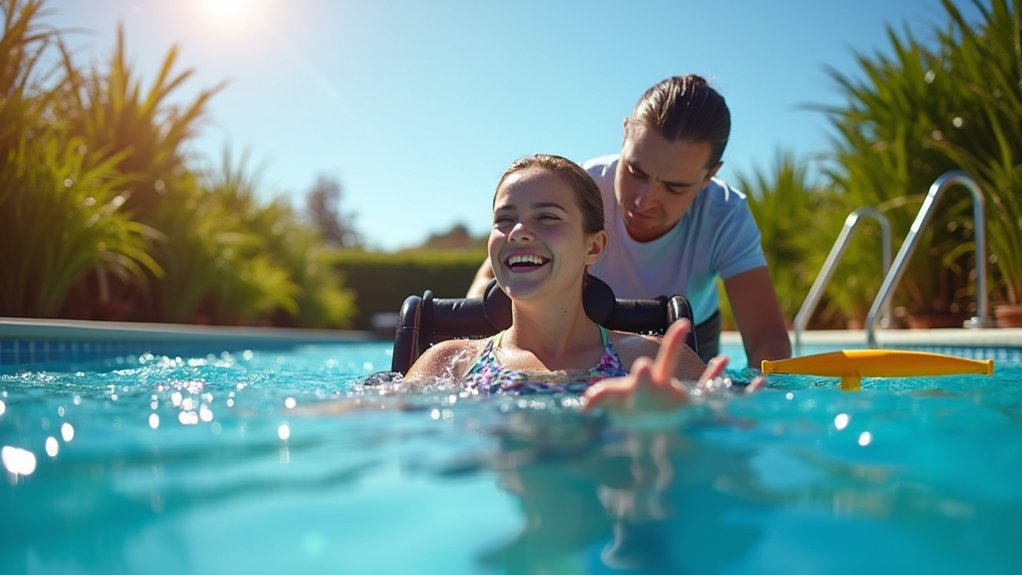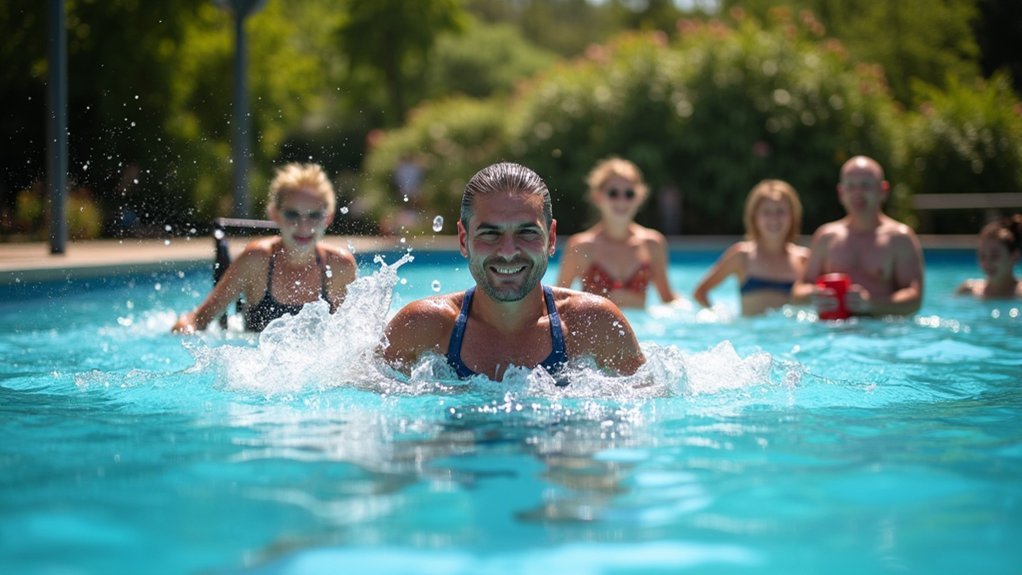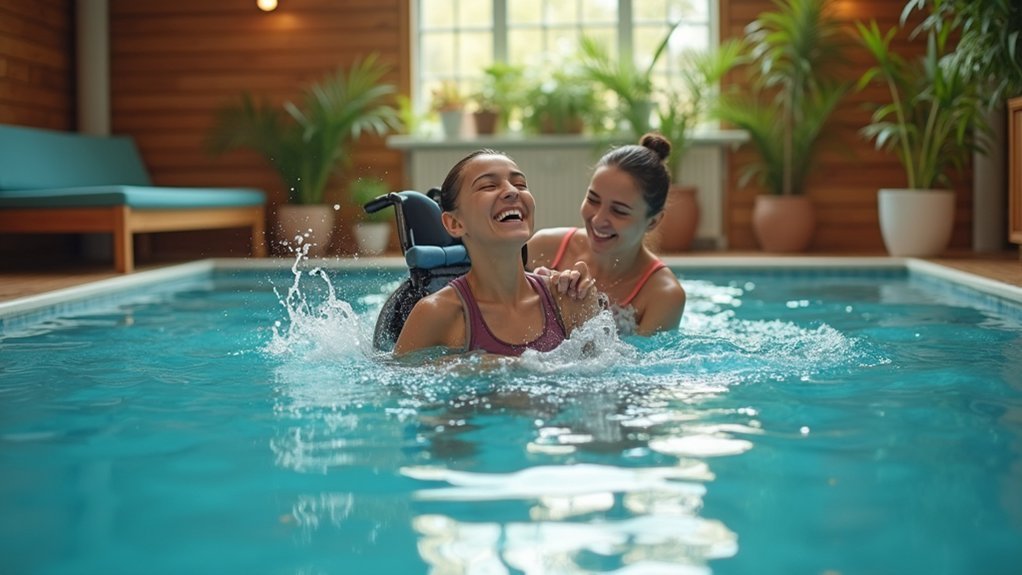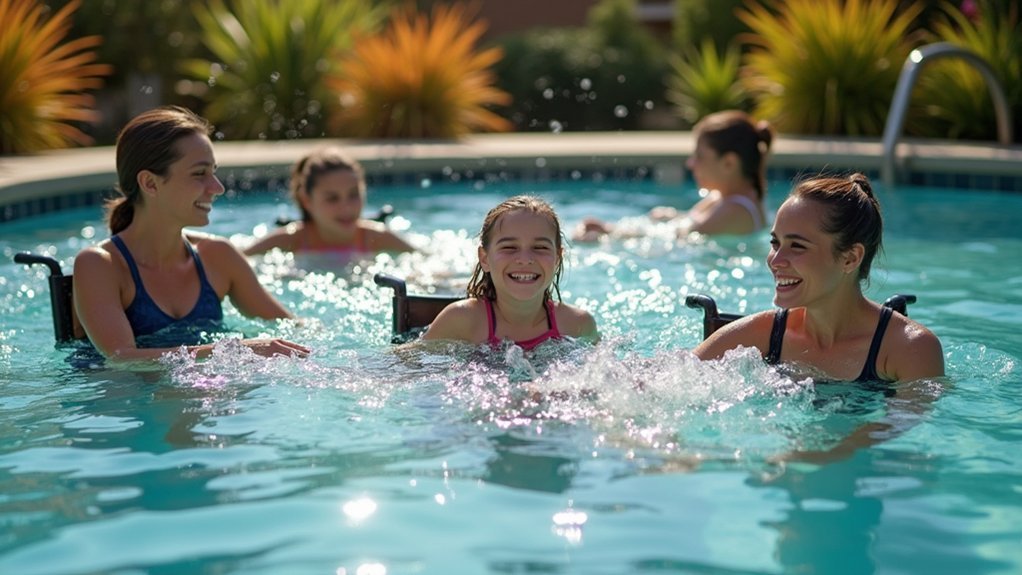Water therapy offers wheelchair users five major benefits: weightless movement thanks to buoyancy, natural pain relief without medication, improved strength through water resistance, enhanced flexibility in warm water, and significant mental wellness boosts. You’ll experience less joint pressure, better circulation, and reduced muscle spasms while building endurance in a supportive environment. The combination of physical relief and mood enhancement makes aquatic therapy a powerful approach for your overall wellbeing. Discover how each benefit transforms daily living.
5 Water Therapy Wins for Wheelchair Users

For individuals who rely on wheelchairs, water therapy offers a uniquely beneficial environment that traditional physical therapy often can’t match.
Water’s buoyancy instantly reduces the pressure on your joints while providing natural resistance that strengthens muscles without strain.
You’ll experience improved mobility as the water supports your body, allowing movements that might be impossible on land. The warm temperature enhances your flexibility and eases muscle spasms, while specialized equipment like pool lifts guarantees you can enter and exit safely.
Beyond physical benefits, you’ll likely notice improved mental wellbeing. The sensory experience of water therapy can reduce anxiety and depression, while group sessions foster valuable social connections. Hydrotherapy helps correct gait and balance issues through the water’s natural resistance.
With accessible facilities becoming more common, you’ll find this therapeutic option increasingly available in your community.
Weightless Mobility: How Buoyancy Creates Freedom of Movement
The physical liberation you experience in water begins with a simple scientific principle: buoyancy. When you enter the pool, gravity’s constant pull diminishes dramatically, allowing your body to move with unprecedented ease.
You’ll notice immediate relief in your joints as water supports your weight, reducing the stress that normally accumulates in wheelchair users. This weightlessness transforms previously difficult movements into achievable actions, expanding your range of motion and flexibility.
Water’s unique environment offers you varied exercise options—from stretching to resistance training—tailored specifically to your capabilities. Water therapy sessions help release tension in hip flexors, which often become stiff due to prolonged wheelchair sitting.
The freedom you’ll experience often leads to increased energy and decreased fatigue compared to land-based activities.
This newfound mobility isn’t just physical—it often enhances your mental wellbeing, boosting self-esteem and motivation to exercise regularly.
Pain Management Without Pills: Aquatic Relief for Chronic Discomfort

While many wheelchair users rely on medications for pain relief, water therapy offers a compelling alternative that addresses chronic discomfort naturally. The warm water’s properties work in multiple ways to ease your pain – its hydrostatic pressure improves circulation and reduces joint swelling, while the thermal effects relax tight muscles.
You’ll find the supportive environment particularly beneficial if you have fibromyalgia or musculoskeletal conditions. The water allows you to exercise with less perceived effort, decreasing your risk of injury while still building strength. Research shows that hydrotherapy significantly reduces spasticity in spinal cord injury patients, potentially decreasing reliance on muscle relaxants.
Beyond the physical benefits, you’ll likely experience psychological improvements too – reduced anxiety, decreased fear of falling, and the social engagement that combats isolation. Unlike medications that often come with side effects, aquatic therapy provides pain management while simultaneously improving your overall wellbeing.
Building Strength and Endurance Through Water Resistance
Unlike traditional resistance training, water-based exercise harnesses natural forces to build strength without strain for wheelchair users. The water’s natural resistance engages your muscles more completely than land exercises, while protecting you from falls and injuries.
You’ll benefit from whole-body movements that simultaneously work multiple muscle groups, improving overall strength and coordination. The metacentric effect created by buoyancy helps activate your core muscles and enhance balance—crucial skills that translate to improved land mobility.
As you progress, you can increase workout intensity simply by adjusting your movement speed in water. The supportive environment delays fatigue, allowing for longer sessions that build cardiovascular endurance. The warm water environment reduces spasticity in individuals with quadriplegia, allowing for more efficient movement patterns.
Many wheelchair users find they can exercise more frequently thanks to reduced pain and anxiety, creating a positive cycle of strength development and improved confidence.
Mental Wellness Benefits: Stress Reduction and Improved Mood

Beyond the physical advantages of water therapy, profound mental health benefits extend to wheelchair users seeking emotional equilibrium. When you enter the water, you’ll experience an immediate calming effect as buoyancy creates a weightless sensation, releasing both physical and mental tension.
You’ll notice reduced stress levels as water immersion naturally decreases cortisol production. The rhythmic movements and soothing sounds create an environment perfect for mindfulness, offering respite from daily sensory overload. The sound of splashing water releases dopamine production, promoting a calmer mindset and enhanced relaxation.
Water therapy also boosts your mood through endorphin release—similar to effects from traditional exercise but with added benefits of accessibility.
Many wheelchair users report significant improvements in self-esteem as they accomplish movements in water that may be challenging on land, fostering independence and confidence that extends beyond therapy sessions.
Frequently Asked Questions
How Long Does Each Hydrotherapy Session Typically Last?
Your hydrotherapy sessions typically last between 20-45 minutes. Professional sessions with a physical therapist usually run 30 minutes, while home practices often need just 15 minutes to deliver therapeutic benefits. Session length varies by condition.
Is Water Therapy Covered by Insurance or Medicare?
Yes, Medicare typically covers 80% of your water therapy costs under Part B when it’s medically necessary and prescribed by an approved professional. Many private insurances also cover it with proper documentation and authorization.
What Temperature Is Ideal for Therapeutic Pools?
For therapeutic pools, you’ll find 90°F (32°C) is generally ideal. However, if you have specific conditions, temperatures vary: MS patients need 80-84°F, fibromyalgia patients prefer 86-96°F, and cardiopulmonary patients benefit from 86-88°F.
Can Caregivers Participate in Water Therapy Sessions?
Yes, you can definitely have your caregiver participate in water therapy sessions. They’ll provide emotional support, help with safety monitoring, and assist with entering or exiting the pool when needed.
Are There Home-Based Alternatives to Professional Hydrotherapy Facilities?
Yes, you can create home-based hydrotherapy with swim spas, adapted bathtubs, hot tubs, or portable devices. You’ll also benefit from therapeutic water play like warm soaks and guided exercises in your own space.
In Summary
You’ve got powerful therapy right at your fingertips with water-based programs. Don’t underestimate the freedom and relief you’ll experience in the pool. Whether you’re seeking pain management, improved strength, or mental wellness benefits, water therapy offers a unique environment where your body can heal and thrive. Try incorporating regular aquatic sessions into your routine—you’ll likely discover benefits that extend well beyond the water.





Leave a Reply